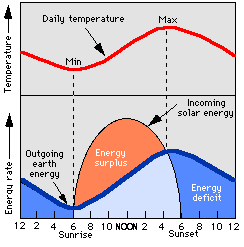| |
Daily Temperature Variations
 Let's look at the energy balance in terms of the daily variations in
temperature. Incoming solar energy is a maximum when the sun is highest in
the sky. But the surface of the earth warms continuously from the time the
sun rises to the time it sets. Therefore, the earth radiates its maximum
amount at sunset, and does not begin to slow down until the sun sets (no
more incoming radiation). The earth is releasing the least amount of
energy early in the morning, before the sun rises. The net energy at the
surface is therefore the difference in the incoming radiation (shortwave)
and the radiation emitted from the earth (longwave). The chart
demonstrates further. Here, the energy surplus area means that more energy
is entering the earth than is leaving it. The deficit area is just the
opposite -- more energy is lost by the Earth than gained (due to the
absence of sunlight). Remember, the total amount of net energy gained is
zero -- there is an energy balance. The surplus area on the chart is
showing the daily replenishment of energy into the Earth-atmosphere system
necessary to maintain that balance.
Let's look at the energy balance in terms of the daily variations in
temperature. Incoming solar energy is a maximum when the sun is highest in
the sky. But the surface of the earth warms continuously from the time the
sun rises to the time it sets. Therefore, the earth radiates its maximum
amount at sunset, and does not begin to slow down until the sun sets (no
more incoming radiation). The earth is releasing the least amount of
energy early in the morning, before the sun rises. The net energy at the
surface is therefore the difference in the incoming radiation (shortwave)
and the radiation emitted from the earth (longwave). The chart
demonstrates further. Here, the energy surplus area means that more energy
is entering the earth than is leaving it. The deficit area is just the
opposite -- more energy is lost by the Earth than gained (due to the
absence of sunlight). Remember, the total amount of net energy gained is
zero -- there is an energy balance. The surplus area on the chart is
showing the daily replenishment of energy into the Earth-atmosphere system
necessary to maintain that balance.
One important item to notice is that the earth's maximum emission of heat
is skewed to the right (toward sunset) of the maximum incoming energy .
Another key observation is that the earth emits and absorbs radiation
much more efficiently than the atmosphere. That is why the late afternoon
is often much warmer than at noon, when the incoming shortwave radiation
is a maximum. That's also why the early morning is the coolest time of
day. The atmosphere warms and cools slowly, but the ground warms and cools
much more quickly. The next time you're outside, feel the ground with your
hand. If it is mid-day, it will feel significantly warmer than the air. If
it is late night, it will feel significantly cooler. Differences in the
rate of radiation absorption and release are a major factor influencing
energy balance. This, and other factors, are discussed in the next section.
Confused? Have a question? If so, check out the Frequently Asked Questions (FAQ) page or send mail to the OS411 tutor (os411tutor@shodor.org) with your question!
Report technical/content problems here
|
|